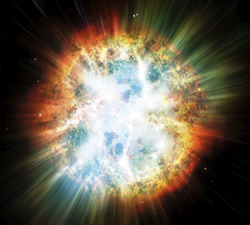The makings of a stellar explosion
Supernovae (SNe, or singular SN) are explosions of stars whose initial brightness can momentarily outshine the intensity of an entire galaxy. SNe are classified as Type Ia, Ib, Ic or Type II. A Type Ia SN is thought to result from the explosion of a white dwarf (WD), a star that has completed its normal life-cycle and no longer exhibits nuclear fusion. Sometimes the mass of the WD increases beyond a certain limit, the so-called Chandrasekhar limit, either by accumulating (accreting) mass from a binary companion star (single-degenerate model, SD) or by merging with another WD (double-degenerate model, DD). When this occurs, the WD will begin to collapse on itself due to the gravitational force of the large mass itself, raising its temperature past the nuclear fusion ignition point and initiating an uncontrolled nuclear reaction. Despite decades of intensive research, the progenitor systems of Ia SNe remain elusive and yet the unsolved problem has important implications for stellar evolution and evolution of galaxies. Most data on Ia SNe have been accumulated from distant SNe outside our own galaxy. However, the large distances prohibit precise measurements of key parameters. European researchers set out to conduct a detailed study of Ia SNe Remnants (SNRs) and binary WDs closer to home in the Milky Way and other galaxies close by with EU funding of the project ‘A close look at type Ia supernova progenitors’ (Sniaprog). Scientists identified two interesting binary WDs that may be relevant to the DD model. Data are currently being analysed and prepared for publication. Investigators also studied WD mergers, merging of two similar and relatively low-mass WDs. Perhaps the most exciting result of the Sniaprog project, published in numerous forums, is that the frequency of WD mergers is similar to the frequency of Ia SN events, providing important support for the DD progenitor model. Fruitful results of numerous other collaborations and scientific visits are helping to solve the mystery of the Ia SN progenitors. Taken together, the Sniaprog project results significantly advanced understanding of the source of Ia SNe, one of the most important unanswered questions in stellar astrophysics.



